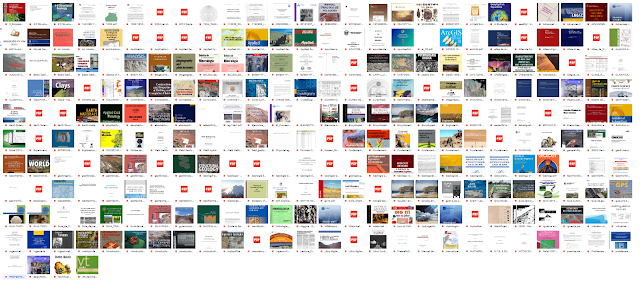martes, 18 de junio de 2019
JOHN RIDLEY
Colorado State University
Ore deposit geology may be taught late in a student’s undergraduate programme, or even at the beginning of a graduate programme. At this stage the student is able to link many of the concepts involved in ore genesis into his or her knowledge of the building blocks of the geosciences. Or it may be taught early, to show students potential applications of their emerging knowledge. This book is designed for the former case and also to be a reference if a student chooses to work professionally in the field. Knowledge typical of standard undergraduate courses in mineralogy, igneous, metamorphic and sedimentary geology, structural geology and tectonics, and geomorphology are assumed, together with some basic chemistry. It is not assumed that students have had courses in isotope geochemistry
or in geochemical thermodynamics.
The subject is scientifically expansive. There are few areas of the Earth sciences which are not touched upon in a thorough study of the subject. A balance needs however to be reached in teaching between detail and breadth. Some geologists work on one deposit type all their lives; others need to have enough knowledge of all types to make suitable judgements when they are called to evaluate them. A balance also needs to be reached between the local and the global. A practising ore deposit geologist may remain in one area or work over the world. The subject thus needs to be taught with case studies from globally, but also tailored to local geology.
It was a truism while I wrote this book, over the years before, and hopefully for at least a few years after, that the professional community of ore deposit geologists needs to become scientifically more sophisticated to be successful in our search for resources to replace those that are being mined. The easy to find, outcropping ores are almost all found. We need to be able to predict the likely positions of ores, and find them and evaluated them with a reasonable success rate through drilling to depths of a few hundred metres. Accurate prediction will require good knowledge of the nature of ore, of empirical markers of ore systems, and accurate conceptual models of how ores form. It is with the aim of training with all the ends and needs listed above this book was written. Description, genetic analysis and discussions of advances in understanding of other sub-disciplines of the geosciences are combined. About 30 deposit types are described and discussed in varying depths.
I made two specific choices in format that warrant some explanation: First, for the benefit of simplicity, I felt the need to take stands on some of the conflicting interpret- ations and debates in the community of ore deposit geologists and to write some of the deposit descriptions and analyses from the viewpoint of one ‘side’. Debate is an integral part of science. Descriptions run the risk of being supplanted as new discoveries are made. Genetic analysis runs an even greater risk. We need to keep aware that at least some of our interpretations, especially of the unknowable of ore genesis in the geological past, are at all times ‘castles in the air’. We need further to be aware that our interpretations can be intensely personal.
Seguidores
GEOFIELD FANPAGE
Entradas Populares
-
MANUAL DE FOTOGEOLOGIA Publicaciones cientificas de la junta de energia nuclear *M. L. LOPEZ VERGARA Fotogeólogo al servicio de l...
-
Depósitos epitermales de alta y baja sulfuración: una tabla comparativa Antoni Camprubí*, Eduardo González-Partida, Gilles Levresse J...
-
Subdivisión de la Placa de Nazca en tres nuevas placas tectónicas y su incidencia con la sismicidad peruana actual* Subdivision of th...
-
MANUAL DE EVALUACION Y DISEÑO DE EXPLOTACIONES MINERAS MADRID 1997 *MANUEL BUSTILLO REVUELTA Doctor en Ciencias Geológicas F...
-
METAMORFISMO Apuntes de la asignatura Petrología Endógena II (Móduo I) *Javier Gómez Jiménez 2006 Metamorphism: a proc...
-
MANUAL DE PROCEDIMIENTON PARA EL REGISTRO GEOTECNICO DE SONDAJES PROYECTO EL CHOCO ESTADO DE BOLÍVAR, VENEZUELA Este docume...
-
LIBROS DE GEOCIENCIAS + DE 500(PRIMERA PARTE) GEOFIELD Comparte la primera parte de LIBROS DE GEOCIENCIAS. Son mas de 500 libros ...
Categories
- DESCARGAS (66)
- GEOLOGIA DE YACIMIENTOS MINERALES (23)
- GEOLOGIA DE CAMPO Y MINAS (19)
- GEOLOGIA ESTRUCTURAL (19)
- PROYECTOS MINEROS (11)
- GEOLOGIA GENERAL (9)
- GEOESTADISTICA - GEOFISICA - SISMOLOGIA - GEOQUIMICA (8)
- GEOMORFOLOGIA (8)
- METALOGENIA (7)
- MINERALOGIA Y CRISTALOGRAFIA (7)
- SEDIMENTOLOGIA Y ESTRATIGRAFIA (7)
- PETROLOGIA IGNEA Y METAMORFICA (5)
- GEOLOGIA DEL PERU (4)
- GEOTECNIA (3)
- GEOTECNIA MINERA (3)
- ESTABILIDAD DE TALUDES (2)
- FOTOGEOLOGIA (2)
- GEOTECTONICA (2)
- BIENVENIDO (1)
- GEOLOGIA DE LOS HIDROCARBUROS (1)
- HIDROGEOLOGIA (1)
- MECANICA DE ROCAS (1)
- PÁGINAS DE GEOCIENCIAS Y MINERÍA (1)
- TOPOGRAFIA MINERA (1)
- VULCANOLOGIA (1)
Blog Archivo
Buscar este blog
Blogroll
ACERCA DE
Con la tecnología de Blogger.
GEOFIELD

GEOFIELD PERU
BUSCAR
LIBROS DE GEOCIENCIAS + DE 500(PRIMERA PARTE)
LIBROS DE GEOCIENCIAS + DE 500(PRIMERA PARTE) GEOFIELD Comparte la primera parte de LIBROS DE GEOCIENCIAS. Son mas de 500 libros ...

Entradas populares
Copyright ©
GEOFIELD | Powered by Blogger
Design by Flythemes | Blogger Theme by NewBloggerThemes.com





























0 comentarios:
Publicar un comentario